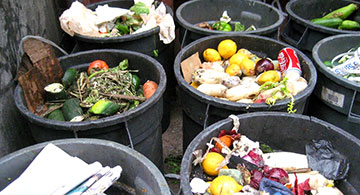One of the key things to adjust to when it comes to living outside of the Philippines are the habits regarding preparing and consuming food. I would say that to a larger extent here, it’s so easy and so convenient to buy food, and lots of it. Ordering take-out food can sometimes lead to ordering too much and that gets tossed out because no one wants to eat it the next day. Many households are also used to cooking for lots of people even though the household size here is smaller, especially when living alone or with roommates.
I remember when I first moved out, I had to adjust to the idea of using a much smaller rice cooker and cooking only one cup of rice every single time. Between my non-Filipino boyfriend, who I was living with, and myself, I was the only one who eats rice. Not being mindful of how much I cook resulted in most of it being thrown in the garbage after the third or fourth day.
When I first came to Canada and lived in Ontario, there was a separate bin where you would throw away compost and organic materials, such as vegetable peels and leftover food. The bin can be a bit gross and smelly if you don’t do it properly, but the system itself wasn’t too surprising to me. It reminded me of the system called ‘kanin baboy’ that was popular in many places in the Philippines. A local family would usually go from home to home, collecting leftover and spoiled food in order to feed the livestock they have in their backyard.
It was a bit surprising that this system wasn’t in place in Edmonton, and leftover food scraps go into in your regular garbage bin or your black garbage bag. It seems like more people are taking it upon themselves to follow home-based solutions like having their own compost system, which is nice.
It is important to consider how much food we waste, both for the sake of the environment, our wallet, and the economy. In 2017 the National Zero Waste Council conducted research on household food waste in Canada. Some key information is as follows. The average Canadian household generates amounts of up to 140 kilograms of wasted food per year – at a cost of more than $1,100 per year. Vegetables, fruits, and leftovers are the largest categories. 2.2 million tonnes of wasted edible food can fill up landfills pretty quickly.
It can be argued that the cause of food waste is because we buy too much, cook too much, or don’t store food properly. So, there are many ways of reducing this. One is to not be ashamed of eating the same dish for multiple meals for the sake of finishing it all. Not cooking something new before all of the leftovers are eaten is a handy strategy.
Freezing something into meal-sized portions that can be conveniently popped into the microwave later is a technique I learned from a family friend during my first year in Canada. A mom of one of our roommates realized that we always don’t have time to cook, so she would make a pan of pasta for us. Afterwards, we would pack the leftovers in sandwich-sized Ziploc bags and put them in the freezer. Remembering that you have these food items in the freezer is just as important though.
Finally, following bylaws and keeping up to date with changes in our area is a good way to help the community and our own households. With this, I wait with excitement for the city-wide implementation of policies that help reduce food waste.
Thoughtfully Thinking about Food Waste



